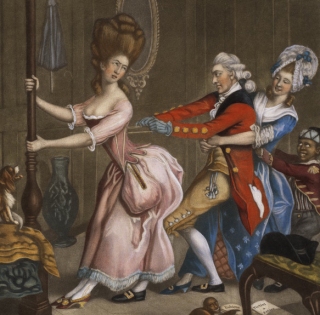
Tight Lacing, or Fashion before Ease by Bowles & Carver ca.1770–1775. The Colonial Williamsburg Foundation
Think Eighteenth Century female undergarments and usually the first article to come to mind is the corset, or stays. Worn over the chemise to cover the breasts and upper torso, stays were made from a variety of materials, cotton to silk, depending on the occasion and most often had a square neckline. The enduring image of a pair of stays is the caricatures of women being laced too tightly; the stays being laced together at the back, and thus requiring an attendant to help dress and undress the wearer. To ensure the requisite conical shape, stays were stiffened with all manner of materials, from buckram (hardened linen or cotton) to whalebone, which also ensured the wearer kept an upright posture. Contrary to popular myth, stays, if worn and laced correctly (it was almost impossible to lace too tightly because eyelets were reinforced with stitching not metal – metal eyelets being a nineteenth century invention) were not uncomfortable and the wearer was able to carry out most everyday duties without hindrance.
A type of stays worn for at-home occasions and often by pregnant and nursing mothers were “jumps”. Jumps were an under bodice similar in shape to stays but without the bones. According to Valerie Steele, author of The Corset, the term comes from the French word jupe – short jacket. Made of silk, cotton or linen and often embroidered, jumps fastened over the breasts with ties such as silk ribbons, buttons and, sometimes, metal hooks.
Jumps were looser fitting than stays and padded with cotton yet still provided support for the breasts while not being restrictive. While mostly worn at home they were sometimes worn out on social occasions as part of an ensemble.
Antonia Dowager Duchess of Roxton in AUTUMN DUCHESS wears jumps every day as a matter of course, and not only for at-home occasions. Then again she can do as she pleases, she is a duchess and thus is a leader not a follower of fashion. But it is not fashion that drives her but comfort. She is a voracious reader and spends a good deal of her time curled up in her favorite wingchair with a good book. Fragonard’s Young Girl Reading (right) reveals by her relaxed posture that she too is wearing jumps Antonia’s husband, the all-powerful Duke of Roxton, Monseigneur, preferred her in jumps. And what man wouldn’t? Removal of stays required considerable effort and two people, with lacings to unravel at the back, when with a tug of a few silk ribbons jumps gaped open to expose as much cleavage as was warranted; the female wearer rendered bare breasted within seconds. Just this thought sends our hero Jonathon’s mind reeling when the widowed Antonia explains to him in a matter-of-fact way the construction of jumps without a thought to the effect her words might have on her rapt male audience of one.
In 1770, Jacques Bonnaud wrote a treatise on the wearing of whalebone corsets arguing that not only was a woman submitting to a form of torture but that such an undergarment went against the laws of nature because stays prevented a woman from breast feeding her newborn infant. So it is not surprising that pregnant women wore jumps that not only had front lacings but side lacings to allow for the expanding bust and waistline of the mother-to-be and allowed nursing mothers to breast feed, something that could not be accommodated if wearing stays.
And it was not until the 1770s when French fashion was leaning toward a simpler style of dress that there was less stiffening in a pair of stays. Women began to eschew whalebone and buckram, preferring quilted linen, and for ease of wear, stays began to be often fastened in the front with strings or ribbons and worn for deshabille, jumps had finally come into their own!
Bibliography
A Glossary of Eighteenth Century Terminology
Steele, V. The Corset: A Cultural History, 2001, Yale
Willett, C. & Cunnington, P.A. The History of Underclothes, 1992, Dover publications
(This article first appeared at History Undressed Reproduced by kind permission)
You can read more about Antonia, Dowager Duchess of Roxton and her preference for wearing jumps and the effect this sexy undergarment has on her suitor, East India Merchant Jonathon Strang in Lucinda Brant’s latest novel, AUTUMN DUCHESS: A Georgian Historical Romance. (Roxton Series Book 3).
Out now in e-book. Print publication due mid-March 2012.
Leave a comment to go in the draw for a paperback or e-book (your choice) of
AUTUMN DUCHESS: A Georgian Historical Romance.
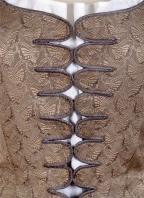
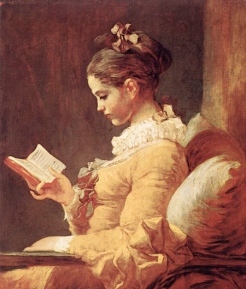
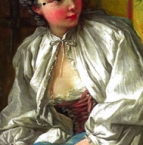
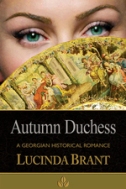

That was an interesting post, Lucinda. Thank you.
Thanks, Gerri. Pleased you enjoyed it!
Thanks! I wondered about those fiesty heroines who were always running off wore. 🙂
Thanks for stopping by JMM! Yes, I’m sure jumps is THE preferred wear for fiesty heroines! : – )
Wonderfully useful post for me, Lucinda. I’m writing about a lady who still has an infant at the breast and I was wondering how she managed that with stays. Also, I’ve told that front-lacing stays were “invented” until about 1816. You place them much earlier (conveniently for me). Do you have a source I can cite?
Thanks much.
Thanks, Grace! Glad to be of use to you. Yes, jumps were around much earlier than 1816! One of the primary sources is the jumps with metal closures above – which is from the mid 18thC. It also has side lacings to allow the jumps to be let out so was most probably maternity wear; you can definitely use this for your breastfeeding lady. Also, the painting La Toilette by Boucher was painted in 1742 and clearly shows front lacings. A secondary source would be Valerie Steele’s excellent work on the history of the corset ( listed above). If you need more just let me know. : – )
“Oh, I can’t run from Lord Evil and his plans to ravish me! There’s no one to unlace me!” 🙂 And I wondered what women wore who didn’t have 20 servants to dress them.
Good information. I’ll make sure that I add autumn Duchess to my list.
Thanks, Vikki! Much appreciated. : – )
Lovely article – thanks. I believe I am right in saying that the young daughter of the diarist John Evelyn died when her tightly-laced stays caused a rib to puncture her lungs. Then, as now, children were under pressure (literally!) to conform to a particular shape. It must have been incredibly hard for energetic young girls to be laced in tightly all day – and I find it interesting that when my gt gt gt gt aunt was sent “to the country” as a young girl her mother had to give permission for her to be allowed to dispense with wearing stays!
Thanks, Mike. I can’t imagine what it must have been like in the 18thC if you were a sporty girl and were compelled to wear stays. I found it difficult enough to wear a school uniform with tie and blazer in the heat of the Australian sun! Yet I believe the stays of the Georgians were not as confining as those of the Victorian age (John Evelyn’s poor young daughter aside) because Victorian stays had metal eyelets which meant the lacings could be pulled even tighter, whereas the eyelets of Georgian stays were hand stitched and would tear if the lacings were pulled too tight, thus limiting constriction. I hope that the use of jumps, or no stays at all, was more common than we think and that, except on the most fashionable/formal of occasions when stays were necessary as part of the whole ensemble, girls and women were able to leave off wearing their stays and breathe easy, like your gt gt gt gt aunt when in the country.
Thank you for such an interesting post. I remember my Mother making my sisters’ and I wear “stays” when we were young girls growing up in in England. They were really uncomfortable and restricting. Also, they were ugly to look at too, nothing like the prettier versions from earlier times. 😦
You’re a new author to me Lucinda, and “Autumn Duchess” sounds like a very interesting and sexy read. I’d love to have an opportunity to read this. 🙂
Hi Diane, thanks for stopping by! I remember my mother in stays and thinking at the time how uncomfortable they looked – and frankly, quite ugly! Vowed never to wear such things. Thank goodness times have changed, but yes, I agree with you, I do like the prettier versions of the 18thC. : – )
Thanks for accepting my friend request on Facebook.
Very interesting post. Always fascinated with the mode of dress in past times and am so glad I don’t have to wear stays or jumps!
Thanks, Terry. I’ll second that!
I wonder if a modern atelier would make jumps? They look much more comfortable and sexier…Thank you for the delicious history snack!
Thanks, Larisa!
Great minds, Larisa, because I was wondering the same thing re a modern atelier making jumps and here is an atelier who does (pink, silk/satin & tiny bows would make it sexier).
See what you think.
Lace Embrace Atelier: http://tiny.cc/dVIe2b
Congratulations to Diane D – Florida who has won a copy of AUTUMN DUCHESS.
Diane, please send me an email to lucindabrant [at] gmail.com to arrange delivery!
Thank you to all who left comments.
Many thanks Lucinda. I’ve sent you an email with my address.
Check out the photos section of Duran Textiles. They have an amazing number of reproduction jumps.
Thanks, Tami! I will. : – )